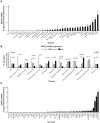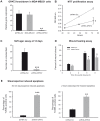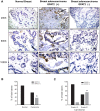Glycerol-3-phosphate acyltranferase-2 behaves as a cancer testis gene and promotes growth and tumorigenicity of the breast cancer MDA-MB-231 cell line
- PMID: 24967918
- PMCID: PMC4072688
- DOI: 10.1371/journal.pone.0100896
Glycerol-3-phosphate acyltranferase-2 behaves as a cancer testis gene and promotes growth and tumorigenicity of the breast cancer MDA-MB-231 cell line
Abstract
The de novo synthesis of glycerolipids in mammalian cells begins with the acylation of glycerol-3-phosphate, catalyzed by glycerol-3-phosphate acyltransferase (GPAT). GPAT2 is a mitochondrial isoform primarily expressed in testis under physiological conditions. Because it is aberrantly expressed in multiple myeloma, it has been proposed as a novel cancer testis gene. Using a bioinformatics approach, we found that GPAT2 is highly expressed in melanoma, lung, prostate and breast cancer, and we validated GPAT2 expression at the protein level in breast cancer by immunohistochemistry. In this case GPAT2 expression correlated with a higher histological grade. 5-Aza-2' deoxycytidine treatment of human cells lines induced GPAT2 expression suggesting epigenetic regulation of gene expression. In order to evaluate the contribution of GPAT2 to the tumor phenotype, we silenced its expression in MDA-MB-231 cells. GPAT2 knockdown diminished cell proliferation, anchorage independent growth, migration and tumorigenicity, and increased staurosporine-induced apoptosis. In contrast, GPAT2 over-expression increased cell proliferation rate and resistance to staurosporine-induced apoptosis. To understand the functional role of GPAT2, we performed a co-expression analysis in mouse and human testis and found a significant association with semantic terms involved in cell cycle, DNA integrity maintenance, piRNA biogenesis and epigenetic regulation. Overall, these results indicate the GPAT2 would be directly associated with the control of cell proliferation. In conclusion, we confirm GPAT2 as a cancer testis gene and that its expression contributes to the tumor phenotype of MDA-MB-231 cells.
Conflict of interest statement
Figures







Similar articles
-
Glycerol-3-phosphate acyltransferase 2 expression modulates cell roughness and membrane permeability: An atomic force microscopy study.PLoS One. 2017 Dec 6;12(12):e0189031. doi: 10.1371/journal.pone.0189031. eCollection 2017. PLoS One. 2017. PMID: 29211789 Free PMC article.
-
GPAT2 is required for piRNA biogenesis, transposon silencing, and maintenance of spermatogonia in mice†.Biol Reprod. 2019 Jul 1;101(1):248-256. doi: 10.1093/biolre/ioz056. Biol Reprod. 2019. PMID: 30951587
-
The protumorigenic enzyme GPAT2 inhibits arachidonic acid-triggered apoptosis in breast cancer.Lipids Health Dis. 2024 Nov 27;23(1):391. doi: 10.1186/s12944-024-02344-1. Lipids Health Dis. 2024. PMID: 39605002 Free PMC article.
-
Transcriptional Regulation of Acyl-CoA:Glycerol-sn-3-Phosphate Acyltransferases.Int J Mol Sci. 2019 Feb 22;20(4):964. doi: 10.3390/ijms20040964. Int J Mol Sci. 2019. PMID: 30813330 Free PMC article. Review.
-
Thematic review series: glycerolipids. Mammalian glycerol-3-phosphate acyltransferases: new genes for an old activity.J Lipid Res. 2008 Oct;49(10):2079-88. doi: 10.1194/jlr.R800013-JLR200. Epub 2008 Jul 24. J Lipid Res. 2008. PMID: 18658143 Review.
Cited by
-
Methylation of the Gpat2 promoter regulates transient expression during mouse spermatogenesis.Biochem J. 2015 Oct 15;471(2):211-20. doi: 10.1042/BJ20150730. Epub 2015 Aug 12. Biochem J. 2015. PMID: 26268560 Free PMC article.
-
Update on glycerol-3-phosphate acyltransferases: the roles in the development of insulin resistance.Nutr Diabetes. 2018 May 25;8(1):34. doi: 10.1038/s41387-018-0045-x. Nutr Diabetes. 2018. PMID: 29799006 Free PMC article. Review.
-
The diversity and breadth of cancer cell fatty acid metabolism.Cancer Metab. 2021 Jan 7;9(1):2. doi: 10.1186/s40170-020-00237-2. Cancer Metab. 2021. PMID: 33413672 Free PMC article. Review.
-
Small non-coding RNA landscape is modified by GPAT2 silencing in MDA-MB-231 cells.Oncotarget. 2018 Jun 15;9(46):28141-28154. doi: 10.18632/oncotarget.25582. eCollection 2018 Jun 15. Oncotarget. 2018. PMID: 29963267 Free PMC article.
-
How lipid droplets "TAG" along: Glycerolipid synthetic enzymes and lipid storage.Biochim Biophys Acta Mol Cell Biol Lipids. 2017 Oct;1862(10 Pt B):1131-1145. doi: 10.1016/j.bbalip.2017.06.010. Epub 2017 Jun 20. Biochim Biophys Acta Mol Cell Biol Lipids. 2017. PMID: 28642195 Free PMC article. Review.
References
-
- Bell RM, Coleman RA (1980) Enzymes of glycerolipid synthesis in eukaryotes. Annu Rev Biochem 49: 459–487. - PubMed
Publication types
MeSH terms
Substances
Grants and funding
LinkOut - more resources
Full Text Sources
Other Literature Sources
Medical
Molecular Biology Databases
Miscellaneous

